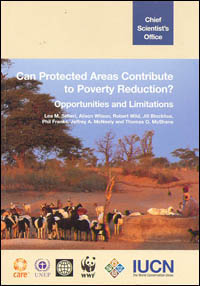Can protected areas contribute to poverty reduction? Opportunities and limitations
Scherl, Lea M.; Wilson, Alison; Wild, Robert; Blockhus, Jill M.; Franks, Phil; McNeely, Jeffrey A.; McShane, Thomas
IUCN, Chief Scientist's Office; Global Environment Facility; WWF; CARE International; World Bank

Photo: IUCN
Poverty has become the central concern for development agencies, and because many of the areas that are most important for conserving biodiversity are occupied by poor people, or have poor people living around them, the relationship between poverty and protected areas can no longer be ignored. The relationship between poverty and protected areas is a complex one, but this book presents a balanced perspective on how protected areas relate to poverty, in both positive and negative ways. On the one hand, protected areas deliver multiple benefits to the people living around them, ranging from tourism to pollination. On the other hand, protected areas may prevent some forms of resource use, and harbour animals that may damage crops in adjacent lands. But by carefully addressing these potential conflicts in an open and inclusive manner, protected area authorities can forge a productive partnership with the rural poor. The issues certainly will require further discussion, but this book provides a useful beginning that is built on a broad consensus of leading organisations working in conservation and development.
Gland : IUCN, 2004. viii, 60p. : ill.
ISBN 2-8317-0809-5 ; DOI 10.2305/IUCN.CH.2005.6.en
Price: 21 USD ; Order number: 2095
